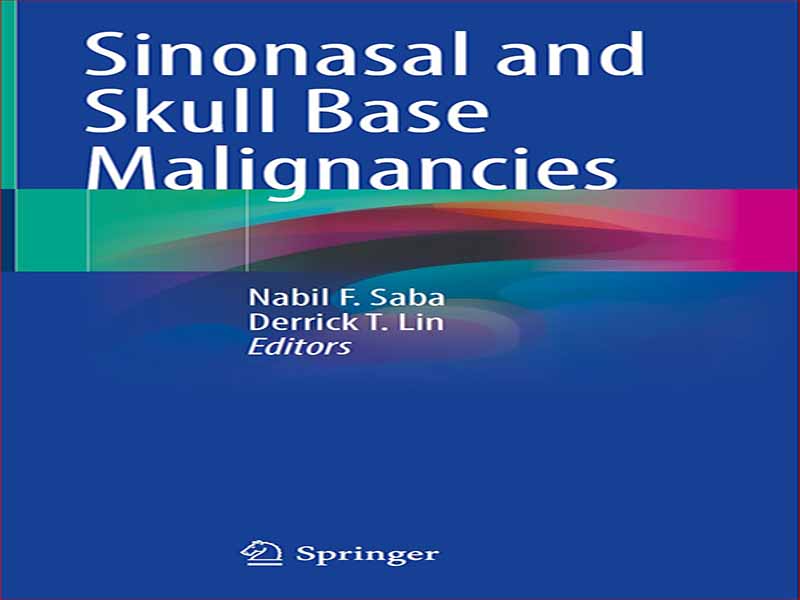- عنوان کتاب: Sinonasal and Skull Base Malignancies
- نویسنده: Nabil F. Saba, Derrick T. Lin
- حوزه: جمجمه
- سال انتشار: 2022
- تعداد صفحه: 283
- زبان اصلی: انگلیسی
- نوع فایل: pdf
- حجم فایل: 13.4 مگابایت
بدخیمی های قاعده جمجمه و سینوس های پارانازال نسبتا نادر هستند و از نظر بافت شناسی و رفتار بالینی ناهمگن هستند. آنها 3 تا 5 درصد از کل سرطان های مبتلا به سر و گردن و کمتر از 1 درصد از کل تومورهای بدخیم را تشکیل می دهند. کارسینوم سلول سنگفرشی سینوس بینی و پارانازال 3 درصد از کل بدخیمی های ناحیه سر و گردن را تشکیل می دهد و چالش هایی را در تشخیص و مدیریت ایجاد می کند. با توجه به ناهمگونی بافت شناسی و آناتومیک بیماری و بروز کم آن، بهبود محسوسی در روش های درمانی وجود ندارد. علیرغم ماهیت اغلب ویرانگر و مخرب این تومورها، پیشرفت های اندکی یا هیچ پیشرفتی در درمان آنها در دهه های گذشته صورت نگرفته است. رویکرد درمانی فعلی برای بیماریهای پیشرفته موضعی معمولاً شامل برداشتن جراحی و پرتودرمانی، با افزودن شیمیدرمانی در برخی موارد بسته به بافتشناسی تومور، محل و همچنین موسسه مدیریتی است. یک رویکرد چند رشته ای اغلب در تشخیص، کار، و مدیریت مورد نیاز است، و نیاز به یک مرجع دقیق از رویکردهای استاندارد فعلی پذیرفته شده را التماس می کند. متخصصانی که در درمان این تومورها دخیل هستند، علاوه بر جراحان گوش و حلق و بینی- جراحان سر و گردن، جراحان ترمیمی، رادیولوژیست های اعصاب، پاتولوژیست های تخصصی سر و گردن، متخصصین پروتز و گفتار و بلع درمانگران و همچنین انکولوژیست های پزشکی و پرتودرمانی می باشند. یک رویکرد فردی برای درمان توصیه می شود و بسته به مورد، اغلب به یک چشم پزشک، جراح مغز و اعصاب، مددکار اجتماعی و همچنین حمایت پرستاری پیشرفته نیاز است. علیرغم این محدودیتها، افزایش قابل توجهی در کشف رویکردهای درمانی جدید در پزشکی، جراحی و پرتودرمانی وجود داشته است که به جزئیات این پیشرفتها اهمیت میدهد.
Malignancies of the skull base and paranasal sinuses are relatively rare, and are heterogeneous in histology and clinical behavior. They account for 3–5% of all cancers affecting the head and neck and less than 1% of all malignant tumors. Nasal and paranasal sinus squamous cell carcinomas account for 3% of all malignancies of the head and neck area and present challenges in diagnosis and management. Given the histologic and anatomic heterogeneity of the disease and its low incidence, tangible improvement in therapeutic modalities has been lacking. Despite the often devastating and disfiguring nature of these tumors, little or no advances have been made in their treatment over the past decades; the current treatment approach for locally advanced disease typically involves surgical resection and radiation therapy, with the addition of chemotherapy in some cases depending on the tumor histology, location, as well as the managing institution. A multidisciplinary approach is often needed in the diagnosis, work up, and management, begging the need for a detailed reference of the currently accepted standard approaches. Specialists involved in treating these tumors include, in addition to otolaryngologist- head and neck surgeons, reconstructive surgeons, neuroradiologists, specialized head and neck pathologists, prosthodontists, and speech and swallow therapists, as well as medical and radiation oncologists. An individualized approach to treatment is advocated, and depending on the case, an ophthalmologist, neurosurgeon, social worker, as well as advanced-nursing support are often needed. Despite these limitations, there has been a noted surge in exploring novel therapeutic approaches in medical, surgical, and radiation therapy, adding importance to detailing these advances.
این کتاب را میتوانید بصورت رایگان از لینک زیر دانلود نمایید.
Download: Sinonasal and Skull Base Malignancies



































نظرات کاربران